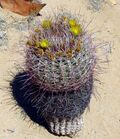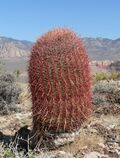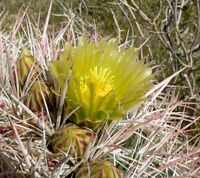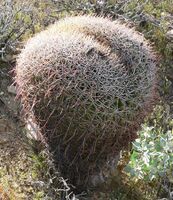Biology:Ferocactus cylindraceus
| Ferocactus cylindraceus | |
|---|---|

| |
| Scientific classification | |
| Kingdom: | Plantae |
| Clade: | Tracheophytes |
| Clade: | Angiosperms |
| Clade: | Eudicots |
| Order: | Caryophyllales |
| Family: | Cactaceae |
| Subfamily: | Cactoideae |
| Genus: | Ferocactus |
| Species: | F. cylindraceus
|
| Binomial name | |
| Ferocactus cylindraceus (Engelm.) Orcutt
| |
| Synonyms | |
|
Echinocactus viridescens var. cylindraceus Engelm. | |
Ferocactus cylindraceus is a species of barrel cactus which is known by several common names, including California barrel cactus, Desert barrel cactus, compass barrel cactus, and miner's compass. It was first described by George Engelmann in 1853.[2]
Distribution and habitat
This cactus is native to the eastern Mojave Desert and western Sonoran Desert Ecoregions in: Southern California , Nevada, Arizona, and Utah in the Southwestern United States; and Baja California, and Sonora state in Northwestern Mexico.[3][4]
It is found in gravelly, rocky, or sandy soils, in Creosote Bush Scrub and Joshua Tree Woodland habitats, from 60–1,500 metres (200–4,920 ft) in elevation.[5]
Description
Ferocactus cylindraceus is usually cylindrical or spherical, usually found in clusters with some older specimens forming columns grow up to 50 centimeters in diameter and 3 metres (9.8 ft) in height. The stem has 18 to 27 distinct ribs and is covered in long, plentiful spines, which are straight and red when new and become curved and gray as they age. Each areola typically contains four to seven central spines that are 5 to 15 centimeters long, as well as 15 to 25 radial spines resembling strong hairs.[6]
The cactus bears funnel-shaped flowers that are maroon outside, and bright yellow inside, with red tints and yellow centers on the side that faces the sun, measuring 3 to 6 centimeters in length and 4 to 6 centimeters in diameter. The fleshy, hollow fruits are spherical, yellow, and about 3 centimeters long.
Subspecies
Accepted Subspecies:[7]
| Image | Subspecies | Distribution |
|---|---|---|
 |
Ferocactus cylindraceus cylindraceus— California barrel cactus.[8] | Southern California to Southwest Utah and Mexico |
| Ferocactus cylindraceus lecontei (Engelm.) N.P.Taylor — Leconte's barrel cactus.[9][10] | Central Arizona | |
 |
Ferocactus cylindraceus tortulispinus (H.E.Gates) N.P.Taylor | Southeast California to South Nevada and Mexico (Northwest Sonora) |
Taxonomy
In 1852, George Engelmann first described Ferocactus cylindraceus as Echinocactus viridescens var. cylindraceus. The name "cylindraceus" is derived from Latin, meaning "cylindrical," which describes the shape of the plant's shoots. In 1926, Charles Russell Orcutt moved this variety to the Ferocactus genus.[11]
Conservation
Having a sculptural form and picturesque qualities, this already uncommon cactus is threatened by plant collectors.[5] It is also losing habitat to clearing for new wind farms and solar power plants in the Mojave Desert and Colorado Desert.
- Protected areas with notable populations include
- Anza-Borrego Desert State Park
- Joshua Tree National Park
- Mojave National Preserve
- Santa Rosa and San Jacinto Mountains National Monument
Gallery
References
- ↑ Burquez Montijo, A.; Felger, R.S. (2017). "Ferocactus cylindraceus". IUCN Red List of Threatened Species 2017: e.T152556A121539513. doi:10.2305/IUCN.UK.2017-3.RLTS.T152556A121539513.en. https://www.iucnredlist.org/species/152556/121539513. Retrieved 22 May 2023.
- ↑ Anderson, Edward F. (2001). The cactus family. Timber Press. p. 327. ISBN 0-88192-498-9. https://books.google.com/books?id=vYXQHL2IsZ4C&q=%22Ferocactus+cylindraceus%22&pg=PA332. Retrieved 28 August 2010.
- ↑ CalFlora Database: Ferocactus cylindraceus . accessed 4.1.2013
- ↑ CalFlora Database: Distribution Map (in California)
- ↑ 5.0 5.1 Jepson . accessed 4.1.2013
- ↑ Flora of North America . accessed 4.1.2013
- ↑ "Ferocactus cylindraceus (Engelm.) Orcutt". https://powo.science.kew.org/taxon/urn:lsid:ipni.org:names:103619-2#children.
- ↑ "Ferocactus cylindraceus (Engelm.) Orcutt var. cylindraceus". Natural Resources Conservation Service PLANTS Database. USDA. https://plants.usda.gov/core/profile?symbol=FECYC.
- ↑ "UC/JEPS: Jepson Manual treatment for FEROCACTUS cylindraceus var. lecontei". https://ucjeps.berkeley.edu/cgi-bin/get_JM_treatment.pl?2702,2717,2718,2720.
- ↑ "Ferocactus cylindraceus (Engelm.) Orcutt var. lecontei (Engelm.) H. Bravo". Natural Resources Conservation Service PLANTS Database. USDA. https://plants.usda.gov/core/profile?symbol=FECYL.
- ↑ Silliman, Benjamin (1852). "The American journal of science and arts". S. Converse. https://www.biodiversitylibrary.org/page/28136824.
External links
- Jepson Manual Treatment — Ferocactus cylindraceus
- USDA Plants Profile: Ferocactus cylindraceus (California barrel cactus)
- Ferocactus cylindraceus in Flora of North America @ efloras.org
- Abdnha.org: species photos
- Ferocactus cylindraceus — U.C. Photo gallery
Wikidata ☰ Q138301 entry
 |







